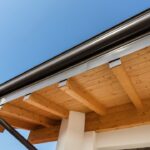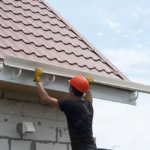Embarking on the journey of how to build a roof is a significant undertaking. Whether you are tackling a small shed or constructing a towering home, the fundamentals of roof-building remain pivotal. A robust roof not just offers shelter but also enhances the overall aesthetic and value of a property.

Types of Roofs
To successfully grasp how to build a roof, you must first acquaint yourself with the various types of roofs available:
Gable Roofs
Commonly seen in residential architecture, gable roofs have two sloping sides that form a peak, akin to an inverted V when viewed from the front.
Flat Roofs
As the name suggests, flat roofs are level structures widely used in commercial, industrial, and some residential buildings.
Hip Roofs
Featuring slopes on all four sides, hip roofs are stable and highly durable, making them a favored choice in areas prone to severe weather conditions.
Materials Needed for Roof Construction
A diverse range of materials is employed in the construction of roofs. Familiarizing yourself with these is crucial in mastering how to build a roof:
Shingles
This crucial element comes in various forms including asphalt, wood, metal, and composite, each offering unique durability and aesthetic qualities.
Underlayment
Providing a secondary and vital layer of protection beneath shingles, the underlayment guards against moisture infiltration.
Trusses
These prefabricated triangular wooden structures serve as the backbone of your roof, supporting the weight and maintaining shape.
Step-by-Step Guide on How to Build a Roof
Once equipped with knowledge and materials, the next step in how to build a roof is to follow a methodical construction process:
Step 1: Planning and Design
Draft a comprehensive plan, considering the style, size, and purpose of the roof. This phase is vital in ensuring the subsequent steps proceed smoothly.
Step 2: Gathering Materials and Tools
Assemble all required resources, from hammers and nails to timber and safety gear. Proper preparation is critical in avoiding unnecessary delays and complications.
Step 3: Installing the Trusses
Position and secure the trusses at regular intervals to ensure a sturdy foundation. Roof company
Step 4: Adding the Sheathing
Sheathing typically comprises plywood or similar materials placed over the trusses to create a smooth surface for subsequent layers.
Step 5: Applying the Underlayment
This protective membrane is rolled out over the sheathing, providing an essential barrier against moisture.Roof replacement cost
Step 6: Installing the Shingles
Following the manufacturer’s instructions, carefully place each shingle ensuring complete coverage and water tightness.
Step 7: Finishing Touches
Finally, secure flashing around chimneys and valleys, seal edges, and perform a thorough inspection to guarantee a durable and secure roof.
The Role of Technology in Modern Roofing
The landscape of roofing has transformed with advancements in technology, significantly impacting the approach towards how to build a roof. Technologies such as drone-assisted inspections, 3D modeling, and improved materials have streamlined processes and enhanced precision and durability.
Drone Technology
Allowing for quick and precise assessments, drones minimize risk and enhance efficiency.EPDM roofing
3D Modeling
This innovation enables virtual visualization, assisting in error reduction and optimization of the design before actual construction begins.TPO roofing
Improved Materials
The introduction of new, more durable materials has led to longer-lasting roofs that can better withstand harsh elements.
Common Mistakes When Building a Roof
Becoming well-informed on potential pitfalls and difficulties is vital when mastering how to build a roof. Awareness of common mistakes will enhance both safety and efficiency in roof construction:
Ignoring Local Building Codes
Failing to adhere to regional regulations can lead to legal complications and mandatory modifications.
Insufficient Ventilation
Improper ventilation might result in mold growth, higher energy expenses, and premature roof deterioration.
Improper Nail Placement
The incorrect use of nails can lead to structural weaknesses, ultimately undermining the roof’s integrity.
Maintaining Your Roof After Construction
Once you have navigated the stages of how to build a roof, ongoing maintenance ensures the longevity and sustained performance of your endeavor:
Regular Inspections
Conduct consistent assessments to detect any signs of wear and tear and prevent future structural failures.
Keeping Gutters Clear
Maintaining clean gutters facilitates proper drainage and averts water accumulation.
Repairing Damage Promptly
Address issues immediately to prevent small problems from escalating into costly repairs in the future.

Frequently Asked Questions
What is the most challenging aspect of learning how to build a roof?
Many find the intricate planning and design phase challenging, as it requires a substantial time investment to ensure precision and accuracy.
Is roofing a DIY-friendly project?
While certain small-scale projects may be manageable, larger or complicated roof constructions often require the expertise and safety assurances of a professional contractor.
How can I select the best materials for my new roof?
The option to select the ideal materials rests in careful assessment of durability, style, and regional weather conditions. Consulting a professional or utilizing roofing materials guide can provide valuable insights.
This article contains affiliate links. We may earn a commission at no extra cost to you.








